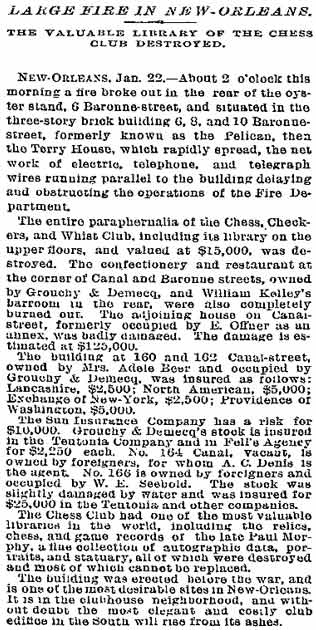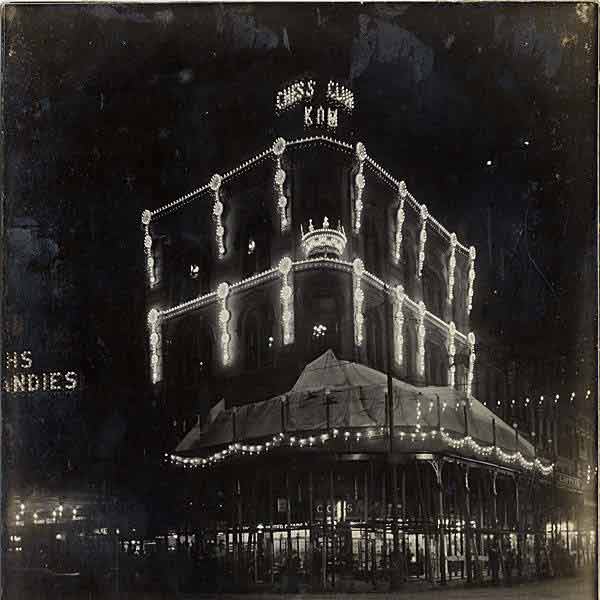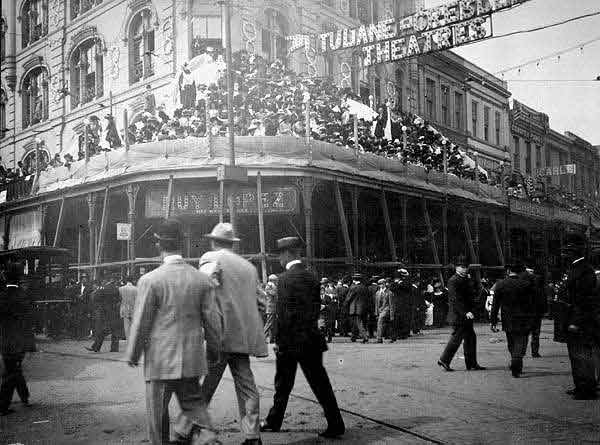|
The New Orleans Chess, Checkers and Whist Club

The New York Times, January 23, 1890
This clipping was provided by
Calli
from chessgames.com
and from the ashes...
The Chess, Checkers and Whist Club came into existence in 1880,
as a result of the enthusiasm of C. A. Maurian, C. F. Buck, and J. D.
Seguin, all devotees of the "king of games." They founded a small club for
the study and cultivation of the game. At first a single room accommodated
the members. This was at No. 128 Gravier Street. The membership, however,
increased rapidly, and by January, 1881, numbered 150. In the meantime
larger quarters had been secured at No. 168 Common Street, and then at No.
170; but in the following year it was found necessary to lease a whole
floor of the building at the corner of Common and Varieties Alley. In 1883
it was removed to handsome quarters at the corner of Canal and Baronne,
where it remained till 1920, when the present quarters — formerly the
Cosmopolitan Hotel — on Bourbon Street were occupied. Fire destroyed the
club building in 1890, but it was immediately rebuilt. In 1881 Capt.
George H. Mackenzie, the famous chess-player, visited the club, and gave a
series of exhibitions. This was the beginning of a delightful custom.
Thereafter the celebrated chess-players of all lands have been at various
times guests of the club, and have played with its members. Among those
who have matched their skill against the membership were Zukertort, Lee,
Steinitz, Pillsbury, and Laskar. The greatest of all chess-players, Paul
Morphy, who was a native of New Orleans, was a member. Down to his death
he frequented the rooms. A fine marble bust of this master, which is one
of the treasured possessions of the club, occupies a prominent position in
its rooms.
-History of New Orleans by John Kendall, 1922

Chess, Checkers and Whist Club, circa 1906

Chess, Checkers and Whist Club, circa 1920
John N. Teunisson , photographer
The three leading carnival societies, Comus, Momus, and Proteus, are
understood to be connected with three of the city's four leading clubs,
all of which stand within easy range of one another on the uptown side of
Canal Street: the Boston Club (taking its name from an old card game); the
Pickwick (named for Dickens' genial gentleman, a statue of whom stands in
the lobby); the Louisiana, a young men's club; and the Chess, Checkers
and Whist Club. The latter association is, I believe, the one that
takes no part in the carnival.
Each of the carnival organizations has its own King and Queen, and the
connection between certain clubs and certain carnival societies may be
guessed from the fact that the Comus Queen and Proteus Queen always appear
on the stand in front of the Pickwick Club, to witness their respective
parades, and that the Queen of the entire Carnival appears with her maids
of honor on the stand before the Boston Club upon the day of Mardi Gras,
to witness the triumphal entry and parade of Rex. As Rex passes the club
he sends her a bouquet—the official indication of her queenship. That
night she appears for the first time in the glory of her royal robes at
the Rex Ball, which is held in a large hall; and the great event of the
carnival, from a social standpoint, is the official visit, on the same
night, of Rex and his Queen, attended by their court, to the King and
Queen of Comus, at the Comus Ball, held in the Opera House.
Passing between the brilliantly illuminated flag-draped buildings, under
festoons of colored electric lights, the street parades, with their
spectacular colored floats, their bands, their negro torch-bearers, their
strangely costumed masked figures, throwing favors into the dense crowds,
are glorious sights for children ranging anywhere from eight to eighty
years of age. Public masking on the streets, on the day of Mardi Gras, is
also an amusing feature of the carnival
- American Adventures: A Second Trip "Abroad at home"
by Julian Street, 1917

The Chess, Checkers and Whist Club, Canal and Baronne Streets,
Mardi Gras, 1908
Archives |

